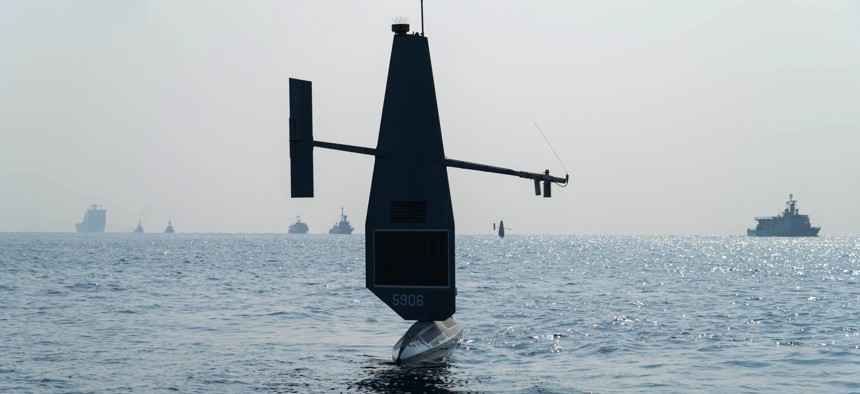
The U.S. Navy's uncrewed systems efforts, like this multinational exercise off Bahrain in October, were cited as an example of a promising direction. U.S. Navy
Is the Pentagon Changing Fast Enough?
So far, two former defense insiders say, new service organizations are more promise than improvement.
The Pentagon is saying all the right things when it comes to defense innovation but real, lasting change isn’t evident just yet, according to two former defense insiders.
“While there are promising things that are being experimented with, they are not getting in the hands of the warfighter yet because of this lag time between a decision to produce something and to actually reach [initial operating capability] and then produce it in numbers,” David Ochmanek, a senior defense analyst for the RAND Corporation, said Monday during a virtual Brookings Institution event on defense innovation and great power deterrence.
Ochmanek, who served as deputy assistant defense secretary for force development from 2009 until 2014, contrasted the U.S. effort with China’s.
“China's not standing still. They're still cranking out hundreds and hundreds of accurate ballistic and cruise missiles every year. They now have the largest Navy in the world…their training is getting more realistic…so we've got to run pretty hard just to stay even with that,” he said.
Chris Brose, the chief strategy officer for Anduril Industries, said previous administrations have not been able to translate their view of China as the pacing threat into fundamental culture and programmatic changes.
“We’re starting to make progress, but I don’t think it’s as much or as fast as it needs to be,” Brose said.
He cited the Navy’s unmanned-systems efforts.
“The Navy has been on a long journey to wrap its head around unmanned systems and embrace the concept. I think they're making strides, they're saying the right things. They're coming to the realization that the only way they're going to have the capacity, the magazine depth that they're going to need is on the back of unmanned systems,” Brose said.
But they haven’t been able to produce, that is building programs around unmanned systems and making it an “enduring priority where you're going to spend a lot of money over a long period of time.”
Ochmanek noted various service efforts to implement reforms, such as the Air Force Warfighting Integration Capability.
“You see every service creating entities to spur innovation, whether it's AFWIC in the Air Force, the Marine Corps Warfighting Lab, Army Futures Command, etc, etc. And that's all good. At the end of the day, it comes down to execution,” he said.
What’s lacking, he said, is a drastic shift in how the services spend money on the things they say they want.
“We've admitted we have a problem. We are focusing on that problem. We are generating ideas and concepts for getting after the problem. I have not seen any service actually take the plunge into altering its investment priorities in a dramatic way to get after what looked like the most promising ways to actually execute these new concepts.”
Brose said it’s a bit too soon to tell but those shifts—including Air Force Secretary Frank Kendall’s operational priorities, designed to drive how the service funds programs—provide something to hope for.
“It's good that we can actually point to a series of things that we can try to be hopeful about. I think the big question is: are we making enough progress fast enough? Thus far, I would say the answer to that is still no.”




